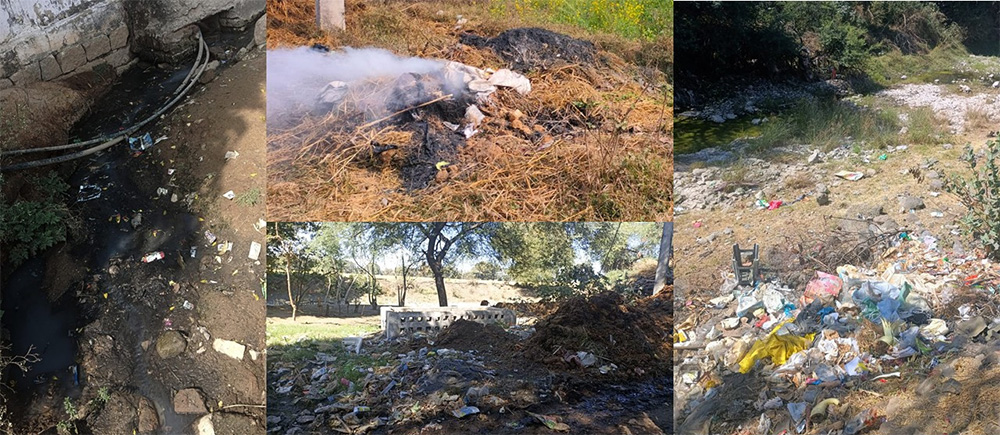Rural India is contending with a growing plastic waste crisis—often overlooked, but with far- reaching consequences. The rise of plastic, once welcomed for its affordability and reach, is now leaving behind a trail that rural areas are struggling to manage.
Across the country, the scale of the challenge is staggering. India generates 26,000 tons of plastic waste every day, yet only 9% is recycled (Commonwealth Scientific and Industrial Research Organisation). Unmanaged plastic breaks down into fragments that linger in the environment for centuries. While urban areas produce 38 grams of waste per capita daily, rural regions generate just 5 grams. This stark contrast has shaped a predominantly urban-focused narrative and response, often overlooking the growing plastic waste crisis in India’s villages.
Convenience-driven consumption has fuelled the rise of sachets and pouches accounting for 35% of FMCG sales from rural India. The widespread use of multi-layered plastic packaging for products like shampoos, biscuits, and gutka adds to the growing plastic waste burden in rural areas. A study by Pratham Foundation found that over 60% of rural households burn non- biodegradable waste, including plastics, releasing toxic, often carcinogenic fumes e.g., dioxins and carbon monoxide. When not burnt, its lightweight leads to littering fields and clogging water bodies. These micro-plastic contaminants seep into the soil and water bodies, finding their way into the food chain.

Policy, Behaviour, Infrastructure: The Three-Fold Strategy for Rural Plastic Waste Management
Recognizing the growing threat, the Indian government has undertaken a comprehensive approach to tackle rural plastic waste by strengthening policy frameworks, launching nationwide campaign to change usage behaviour, and allocating budgets for necessary infrastructure.
The 2016 Plastic Waste Management Rules enforced by the Central Pollution Control Board extended coverage to rural areas, assigning panchayats the responsibility to ban open burning and plastic littering; prohibit the use and manufacture of thin polythene bags (< 120micron) and promote eco-friendly alternatives. The Mission LiFE (Lifestyle for Environment) campaign encourages people to shift from a throwaway culture to a more sustainable, circular way of living. Since 2020, the Swachh Bharat Mission (Gramin) Phase II has been focusing on building rural waste infrastructure compost pits, segregation sheds, waste collection vehicles, and Plastic Waste Management Units which serve as centres for sorting and processing plastic waste.
While efforts of SBM (Gramin) have brought in significant infrastructure; sustained impact depends on community adoption — a gap that persists in many villages. With limited awareness, that burning becomes the default, without the knowledge of its impact. The scattered nature of rural households leads to low waste volumes, making regular collection unviable. Moreover, the dominance of multi-layered plastics limits the optimum utilisation and revenue potential of large material recovery centres at the block level.

Addressing these gaps requires a pragmatic approach anchored in local leadership, community participation, and innovative financing. In Kaladwas panchayat, Rajasthan, a door-to-door collection system thrives through convergence with State Finance Commission funds. Likewise, Jeridih East, Jharkhand, sustains its waste management efforts via a monthly ₹40 household fee per household. An innovative approach, integrating technology is adopted in Shahzadpur Kanaini, Uttar Pradesh, where GPS-based tracking of waste collection vehicles complements a plastic shredding unit that recycles waste into road construction materials. The panchayat also runs a vermicomposting unit led by a women’s SHG, earning ₹13 lakhs in 3 years, setting a benchmark for rural India.
Reviving traditional practices such as using stitched-leaf cutlery / banana leaves at rural events, can help reduce single use plastics. Equally crucial is fostering community ownership of waste segregation and collection. Awareness campaigns must inspire household to segregate waste consistently and encourage depositing it at accessible community bins. Panchayats, in their Gram Panchayat Development Plans must include budgets to install waste infrastructure like bins and sorting sheds encouraging effective waste management. This enables viable volumes for transport, while a modest user fee can reinforce collective responsibility.
For these approaches to take root, the primary step is to equip local leadership with right tools and knowledge. Structured capacity building program can support sarpanches, village committees, block officers in translating intent into implementation. From generating awareness to making optimal use of available funds, targeted training can strengthen each link of the chain. States can also activate WASH training cell as suggested under SBM-G to institutionalise these efforts.
Forward linkages are key to closing the loop. States can act as enablers by creating a repository of companies that repurpose multi-layered plastic waste — such as cement manufacturers, road contractors, and waste-to-energy plants. Toll-free helpline can guide panchayats or block centres in strengthening these partnerships, turning waste into a resource and rural challenges into circular solutions.
As India advances toward Viksit Bharat, it’s incumbent to address the foundational challenge of rural plastic waste management. Sustainable progress can happen only when villages – where a majority of India resides — adopt effective waste management practices. This World Environment Day is a timely reminder to empower communities to reduce, segregate, and repurpose waste for building a cleaner, greener Bharat.
This article was first published on June 5, 2025 in Hindustan Times
TAGS
SHARE





